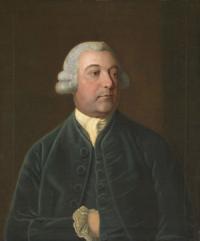 Thomas Slade, a pioneering naval architect and shipwright, died in 1771, 250 years ago today. While he is most famous for the design and construction of Admiral Horatio Nelson’s Victory, his larger contribution to the Royal Navy and even in Nelson’s victory at Trafalgar itself, can not be overstated.
Thomas Slade, a pioneering naval architect and shipwright, died in 1771, 250 years ago today. While he is most famous for the design and construction of Admiral Horatio Nelson’s Victory, his larger contribution to the Royal Navy and even in Nelson’s victory at Trafalgar itself, can not be overstated.
N.A.M. Rodger wrote of Slade: The ships which [he] designed…were admirably suited to Britain’s strategic requirements…By common consent, Slade was the greatest British naval architect of the century…it was generally agreed (even by themselves) that his successors, though competent designers, never matched his genius.
Slade was born in 1703 or 1704 to a shipbuilding family based in Ipswich and Harwich. The nephew of Benjamin Slade, the Master Shipwright at Plymouth Dockyard, he started out as a shipwright in the Royal Dockyards. In 1744, Thomas Slade became Deputy Master Shipwright at Woolwich Dockyard. On November 22, 1750, he replaced his uncle, who had died that year, as Master Shipwright at Plymouth.
He was appointed Surveyor of the Navy in August 1755 serving until his death. For the first decade, he shared the appointment with William Bately, formerly the Deputy Surveyor of the Navy, until the latter’s retirement in June 1765.
Slade produced a ‘standard design’ that was used as a template for the Royal Navy‘s 74-gun ships and frigates. His ’74’ designs, starting with the Dublin-class, were an evolution of current British ships, built to compete with the new French ’74’s, some of which had been captured during the War of Austrian Succession in 1747. At least forty-six ’74’s were built to his designs; the last was launched in 1789.
Victory was his most famous single vessel. Once commissioned, she became the most successful first-rate ship of the line ever built. She has had an exceptionally long carrier. She was ordered in 1758, the same year that Horatio Nelson was born. Now in a drydock in Portsmouth, she is the oldest commissioned warship in the world.
The relationship between ships’ captains and shipbuilders is symbiotic. A captain is nothing without a well-built ship to command and building a stout ship is pointless without a capable commander and crew to sail it.
Out of the 33 ships which were available to Nelson at Trafalgar, eight (Africa, Victory, Agamemnon, Bellerophon, Defiance, Thunderer, Defence, and Prince) were built to Thomas Slade’s designs. Two more of his ships (Swiftsure and Berwick) had been captured by the French earlier and fought on the French side. Slade’s designs represented 24% of Nelson’s ships and 29% of his guns.
Knighted in January 1768, Sir Thomas Slade died on February 23, 1771, in Bath, and is buried in St Clement’s churchyard, Grimwade Street, Ipswich.
Thanks to David Rye for contributing to this post.
